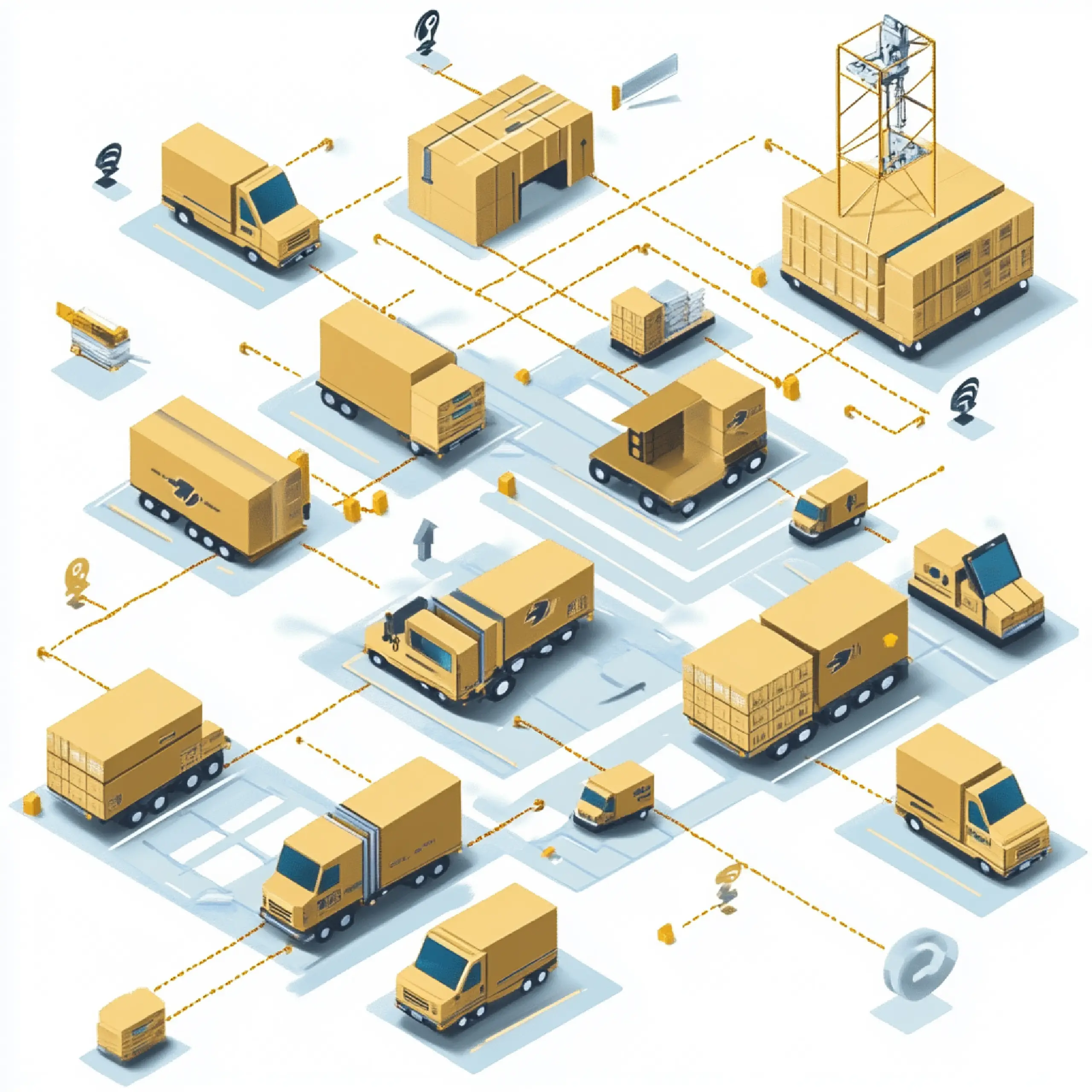The Turbulent Start of Cross-Border E-Commerce in 2025: Challenges and Opportunities, Where is the Future Heading?

The cross-border e-commerce industry in 2025 demonstrates remarkable growth, driven by technological advancements and global consumer demand. With projected revenue reaching $3.4 trillion, it now accounts for 25% of global e-commerce sales. This sector is expanding at a compound annual growth rate (CAGR) exceeding 15%, reflecting its increasing significance in global trade. However, businesses face challenges such as navigating regulatory frameworks and managing logistics across borders. These hurdles create opportunities for innovation, particularly in areas like AI-driven solutions and sustainable practices. Companies that adapt to these dynamics position themselves for long-term success in the evolving ecommerce landscape.
Key Challenges in Cross-Border E-Commerce
Regulatory Compliance in Cross-Border E-Commerce
Navigating international trade laws and customs
Cross-border ecommerce businesses face significant hurdles in navigating international trade regulations. These include understanding complex customs procedures, adhering to diverse data protection laws, and adapting to evolving tax requirements. Companies must also stay informed about regional trade agreements to avoid compliance risks. Automated solutions, such as AI-driven tools, are becoming essential for handling regulatory changes and compliance efficiently. Businesses that fail to adapt risk delays, penalties, and reputational damage.
Addressing tariffs and tax complexities
Tariffs and taxes present another layer of complexity for cross-border e-commerce. The introduction of reciprocal tariffs by major economies has increased costs for businesses. Companies must implement flexible strategies to manage these financial burdens. Automated tax calculation tools and partnerships with experienced logistics providers can help businesses navigate these challenges effectively. Staying updated on global tax policies ensures smoother operations and reduces the risk of unexpected expenses.
Logistics Inefficiencies in Cross-Border E-Commerce
Supply chain disruptions and delays
Supply chain disruptions remain a critical issue for cross-border ecommerce. Factors such as geopolitical tensions, natural disasters, and labor shortages contribute to delays. Businesses must adopt robust supply chain management systems to mitigate these risks. Real-time tracking and predictive analytics can enhance visibility and improve decision-making. Companies that prioritize supply chain resilience can maintain customer trust and ensure consistent delivery.
High shipping costs and limited infrastructure
Rising shipping costs have become a financial burden for cross-border ecommerce businesses. Major parcel carriers have increased their rates by up to 10% compared to the previous year. Passing these costs onto customers often leads to reduced sales and higher return rates. Limited infrastructure in emerging markets further complicates logistics. Strategic partnerships with logistics providers and investments in regional warehouses can help businesses optimize costs and improve delivery efficiency.
Emerging Opportunities in Cross-Border E-Commerce
Advancements in AI for Cross-Border E-Commerce
AI-driven customer insights and demand forecasting
Artificial intelligence (AI) is revolutionizing cross-border ecommerce by providing businesses with precise customer insights and demand forecasting capabilities. AI analyzes consumer behavior, sales trends, and external factors to predict demand accurately. This optimization of inventory levels and production schedules enhances operational efficiency and customer satisfaction.
Dr. Dat emphasized that AI’s ability to automate personalized customer experiences and enable data-driven decisions is critical for businesses looking to expand into new markets. The key is precision and speed—two elements that AI uniquely delivers.
AI-driven tools also improve e-commerce conversion rates by offering tailored product recommendations. Marketing automation ensures timely engagement with customers, particularly when they are about to leave a site. These advancements empower businesses to unify customer data across touchpoints, optimizing their strategies for growth.
Automation in inventory and supply chain management
Automation in inventory and supply chain management is another transformative application of AI in cross-border e-commerce. Businesses can now leverage AI to streamline operations, reduce errors, and enhance supply chain visibility. Real-time tracking and predictive analytics allow companies to anticipate disruptions and adjust logistics strategies proactively. These innovations not only improve efficiency but also strengthen customer trust by ensuring timely deliveries.
Personalized Shopping Experiences in Cross-Border E-Commerce
Tailored product recommendations and localization
Personalized shopping experiences have become a cornerstone of cross-border ecommerce. Tailored product recommendations, powered by AI, cater to individual preferences, enhancing the customer experience. Localization efforts, such as adapting product descriptions and interfaces to regional languages and cultural nuances, further improve customer satisfaction. Retailers who prioritize these elements can build loyalty and stand out in the competitive e-commerce landscape.
Enhancing customer engagement through data analytics
Data analytics plays a pivotal role in enhancing customer engagement. By analyzing feedback and reviews, businesses can identify areas for improvement in the customer experience. Historical purchasing data and browsing patterns enable the creation of personalized shopping experiences. Additionally, insights into market trends and campaign effectiveness help optimize marketing strategies, maximizing return on investment. Businesses that utilize analytics to understand customer behavior can implement precise marketing activities and improve website design, leading to higher conversion rates.
Technological Innovations Driving Cross-Border E-Commerce

AI-Driven Fraud Detection in Cross-Border E-Commerce
Real-time monitoring and predictive analytics
AI-driven fraud detection has become a cornerstone of cross-border ecommerce security. Real-time monitoring systems identify suspicious activities instantly, minimizing the potential damage caused by fraudulent transactions. Machine learning algorithms adapt to evolving fraud patterns, enhancing their detection capabilities over time. By integrating global fraud databases, businesses can cross-reference transactions against known fraudsters, ensuring a higher level of protection. These advancements not only safeguard sensitive customer data but also build trust in cross-border e-commerce platforms.
Enhancing transaction security for global trade
AI-powered tools significantly enhance transaction security in global trade. Predictive analytics identify vulnerabilities before they can be exploited, reducing risks associated with cross-border payments. Businesses can implement multi-layered security protocols, such as biometric authentication and tokenization, to protect financial data. These measures ensure that cross-border ecommerce transactions remain secure, fostering consumer confidence and driving growth in the industry.
Market Trends and Consumer Preferences in Cross-Border E-Commerce

The Rise of Social Commerce in Cross-Border E-Commerce
Leveraging influencers for product promotions
Social commerce is reshaping cross-border ecommerce by leveraging influencers to promote products. Influencers, particularly those with localized appeal, play a pivotal role in connecting brands with target audiences. Retailers are increasingly collaborating with influencers to create authentic content that resonates with consumers. This strategy not only enhances brand visibility but also builds trust among potential buyers. Reports indicate that 59% of consumers are likely to purchase from international merchants via social platforms, driven by personal recommendations and engaging interactions. By integrating influencer marketing into their strategies, businesses can tap into new marketplaces and drive growth.
Seamless shopping experiences on social platforms
Social platforms are evolving into full-fledged marketplaces, offering seamless shopping experiences. Features like in-app purchases, personalized recommendations, and integrated payment options simplify the buying process. Consumers value these conveniences, with 54% planning to increase online purchases from overseas merchants. Retailers adopting these e-commerce trends benefit from enhanced customer engagement and higher conversion rates. Competitive pricing, fast shipping, and robust return policies further solidify consumer trust, making social commerce a key driver of cross-border e-commerce growth.
Localization in Cross-Border E-Commerce
Adapting to regional languages and cultural nuances
Localization remains a cornerstone of success in global markets. Businesses must adapt their messaging, imagery, and product offerings to align with regional languages and cultural nuances. For instance, using culturally relevant imagery and appropriate language fosters a deeper connection with local audiences. Localization also involves offering region-specific payment methods, which enhance convenience and trust. By tailoring their approach, businesses can effectively navigate diverse consumer behavior and establish a strong presence in new marketplaces.
Implementing region-specific marketing strategies
Region-specific marketing strategies significantly improve cross-border ecommerce success. Localization involves modifying site copy, product variations, and marketing campaigns to cater to specific regions. This approach addresses cultural differences and consumer expectations, ensuring relevance and resonance. Placing inventory in local warehouses further enhances customer experience by reducing transportation costs and delivery times. As a result, businesses can enter global markets more effectively and capitalize on emerging opportunities.
Localization is essential for cross-border e-commerce. Tailoring strategies to regional preferences, including language and imagery, ensures businesses connect with local audiences and meet their expectations.
Strategies for Success in Cross-Border E-Commerce
Leveraging JUSDA's Supply Chain Solutions
Optimizing logistics with JUSDASR for cross-border e-commerce
Efficient logistics remain a cornerstone of cross-border e-commerce success. JUSDASR, JUSDA's specialized cross-border logistics service, empowers businesses to streamline operations. Its strategic warehouse locations across the United States reduce transit times and costs, ensuring timely deliveries. By integrating with major carriers like FedEx and UPS, JUSDASR enhances last-mile delivery reliability. Additionally, its dropshipping capabilities allow merchants to respond swiftly to market demands, optimizing inventory management. These features make JUSDASR an essential tool for businesses aiming to scale their cross-border operations effectively.

JUSDA Solutions
To provide you with professional solutions and quotations.
Enhancing efficiency with JusLink intelligent supply chain
JusLink, JUSDA's intelligent supply chain platform, leverages IoT, cloud computing, and big data to revolutionize supply chain optimization. Real-time tracking and predictive analytics enable businesses to anticipate disruptions and adjust strategies proactively. JusLink's ability to integrate disparate systems ensures seamless data flow, enhancing decision-making and operational efficiency. By adopting JusLink, businesses can reduce costs, improve transparency, and strengthen their cross-border logistics networks.
Investing in Technology for Cross-Border E-Commerce
Implementing AI and machine learning tools
AI and machine learning tools are transforming cross-border ecommerce by optimizing operations. Predictive analytics forecast demand and streamline inventory management, reducing overstock and shortages. AI-powered chatbots provide 24/7 customer support, improving response times and enhancing user experiences. Additionally, AI analyzes shipment data to determine efficient delivery routes, minimizing costs and delays. These technologies enable businesses to adapt to market trends and maintain a competitive edge.
Strengthening cybersecurity measures
Cybersecurity is critical for protecting cross-border ecommerce operations. Businesses must implement multi-layered security protocols, including biometric authentication and tokenization, to safeguard financial transactions. AI-driven fraud detection systems monitor activities in real time, identifying and mitigating threats. Regular security assessments and compliance with global data privacy regulations further enhance protection. These measures build consumer trust and ensure the integrity of cross-border transactions.
Targeting Niche Markets in Cross-Border E-Commerce
Identifying underserved regions and demographics
Targeting underserved regions offers significant growth opportunities in cross-border ecommerce. Businesses can analyze demographics, consumer spending metrics, and regional behavior to identify potential markets. For example, Southeast Asia, with its growing middle class and increasing internet penetration, presents high growth potential. Utilizing tools like Country Commercial Guides helps businesses rank markets based on profitability and focus efforts on promising opportunities.
Key Insight | Description |
|---|---|
Demographics | Identifying age and audience volume aids in targeting potential markets. |
Consumer Spending Metrics | Average spending indicates market profitability. |
Regional Consumer Behavior | Tailored offerings meet local needs effectively. |
Government Resources | Trade patterns provide insights into market potential. |
Offering specialized products and services
Focusing on niche markets allows businesses to differentiate themselves in competitive cross-border ecommerce landscapes. For instance, Shein's modest fashion catalog for the Middle East strengthened its brand presence in the region. Offering specialized products tailored to local preferences enhances customer loyalty and increases brand visibility. This approach also diversifies revenue streams, reducing reliance on a single economy and providing stability during market fluctuations.
Cross-border e-commerce in 2025 offers businesses both challenges and opportunities. Companies must adopt innovative strategies and prioritize sustainability to navigate this dynamic landscape. Solutions like JUSDASR and JusLink empower businesses to streamline operations and achieve efficiency. By leveraging technology and fostering collaboration, companies can address cross-border complexities and unlock growth potential. The future of cross-border ecommerce lies in consumer-centric approaches, where adaptability and technological advancements drive success in the global marketplace.
See Also
Exploring Supplier Connections in Global E-commerce Innovations
Transforming Logistics: The Digital Technology Revolution Ahead
Enhancing Global E-commerce Through Supply Chain Transparency
Assessing Your Supply Chain's Preparedness for Digital Transformation
